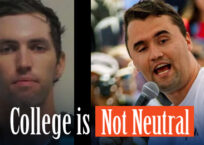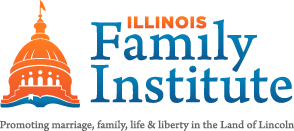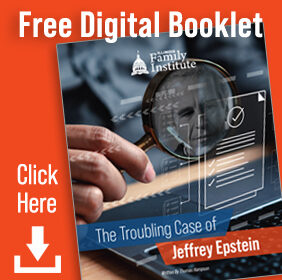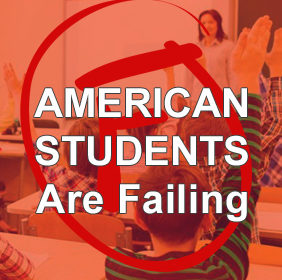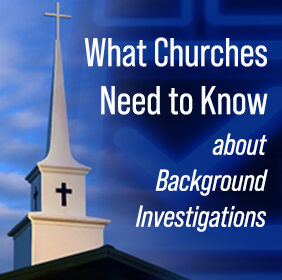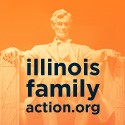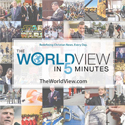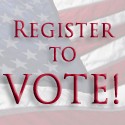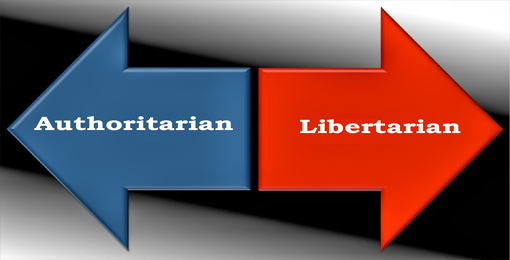
Our language restricts our understanding of the truth. It often keeps us from seeing what is clearly in front of us.
An example is the division of our political views between left and right.
For as long as I can remember, political positions have been described as either left or right. The left is seen as liberal, and the right as conservative. What has always been confusing is that within each of our two main political parties, the Democrats and the Republicans, there are liberal and conservative wings, with moderates in the middle.
There were conservative Democrats who were considered more conservative than liberal Republicans. And liberal Republicans who were just as liberal as liberal Democrats.
Over the past few decades, everything has shifted, especially in the last 10 years. The Democrats have become the party of Hollywood, academia, the media, Wall Street, government workers, unions, and all the intersectional communities (i.e., all the DEI groups). Republicans, particularly Make America Great Again (MAGA) Republicans, have positioned themselves as populists.
If the Democrats still possess a conservative wing, it clearly does not seem to overlap with liberal Republicans at all. There is a significant gap between the two parties.
Of course, the number of Independents has increased significantly over this period as well. It is the Independents who influence the election outcomes. Forty-six percent of Americans identify as Democrats or lean Democratic. Forty-three percent are Republican or lean Republican. Eleven percent are Independents.
Today, more than ever, Democrats tend to be liberal. Republicans are generally conservative. And Independents usually fall in the middle, as moderates. In all national elections, Independents play a crucial role in determining the result.
In modern terms, Democrats are seen as the left, while Republicans are viewed as the right.
This causes some problems in determining which groups are supported by our major parties. The most liberal Democrats—Alexandria Ocasio-Cortez, Bernie Sanders, and Zohran Mamdani—have declared themselves Democratic Socialists, but promote ideas that are communist. Several prominent Democrats have endorsed Mamdani and support AOC and Sanders.
Díaz-Canel of Cuba is a communist, as was Castro. Maduro of Venezuela is a socialist. All these men are brutal killers. All are identified as leftists. Do the socialist Dems support them?
Conservative Republicans, the right, on the other hand—Donald Trump, J.D. Vance, Ron DeSantis, the late Charlie Kirk, Elise Stefanik—have been publicly labeled as Nazis. Almost all MAGA Republicans support Trump and his administration. The Nazis were responsible for about 13 million civilian and prisoner deaths, plus an estimated 40 to 50 million deaths from WWII.
Are President Trump and his supporters a resurgence of the Third Reich?
I don’t believe for a second that Bernie Sanders, AOC, or Zohran Mamdani want to recreate Castro’s Cuba or Maduro’s Venezuela here. Likewise, there is no comparison between President Trump and his administration and Hitler and his government.
Herein lies the problem. The real division in our political culture is not left and right. It’s not liberal and conservative. It’s not even Democrat and Republican. The divide occurs on a continuum from authoritarian to libertarian.
Until we can see this, until we can recognize and understand the true nature of our divisions, we won’t even begin to heal the hostility, the entrenched polarization, and the widening ideological chasm in our society.
I realized there was a flaw in how we described our political differences, dating back to the late 1960s. Back then, anti-war activists were labeled as left-wing. Those of us who supported the war were called right-wing, even fascists. I didn’t see myself that way. At the time, I was an active member of the U.S. Air Force and stationed in Germany, which was once the center of fascism. In fact, we were still technically part of the occupying forces of the defeated Nazi Reich.
The war had ended just 20 years earlier, and stories of Nazi atrocities were still being uncovered and revealed. Germany was not permitted to have a military until 1955, and even afterward, there were still restrictions. Among them were:
- No offensive weapons (e.g., long-range missiles, nuclear arms)
- Strict troop limits and oversight
- No general staff or war planning authority
The occupation did not entirely come to an end until 1991.
Despite being called a fascist or a Nazi by anti-war activists, I knew I was no such thing. It was an absurd slur. I believed in our founding principles and documents and had sworn to uphold them as an active member of the armed forces at the time. I didn’t give much thought to the false claims of those we called draft dodgers.
Years later, in the mid-1970s, after leaving the military and working as an investigator for the Illinois Legislative Investigating Commission, I was directly faced with this flawed view of our political divide when I was assigned to infiltrate the Ku Klux Klan and other “right-wing” groups that had mobilized to oppose the “leftist” groups that had grown both to protest the war and supposedly to promote civil rights.
I rose to become the second-highest-ranking Klansman in Illinois. Before that role, I conducted extensive investigations into the Weather Underground, the Black Panthers, and the Black Liberation Army.
This experience taught me something that challenges traditional political wisdom: the groups we instinctively label as “far-right” and “far-left” have much more in common with each other than they do with mainstream conservatives or liberals.
I didn’t learn this from textbooks. I learned it sitting in Klan meetings, talking to leaders of the Nazis, the National States Rights Party, Minutemen, and others who thought terror could pass for politics.
What I saw convinced me that America debates politics on the wrong axis.
The real axis isn’t left versus right; it’s Authoritarian vs. Libertarian. The left-right label reduces governance, economic policy, and cultural values into one category, hiding the true nature of these movements, which is the pursuit of centralized, unaccountable power.
Christopher Wray and others have argued that right-wing groups are the biggest threat of violence in America, citing Timothy McVeigh, white supremacist organizations, and the historical violence of the KKK. However, my undercover experience showed me something quite different: there was nothing conservative about Timothy McVeigh and there is nothing conservative about these groups.
Nothing about their ideology aligns with the conservative principles of limited government, individual liberty, constitutional governance, or free markets.
As a conservative with libertarian leanings and an America First nationalist, I found absolutely nothing in common with the people in these extremist groups. The Klansmen, and others like them, whom I lived among for two years, didn’t care about constitutional rights or individual freedom. They wanted an all-powerful government, just one that would impose their twisted vision of society.
Constitutional conservatism, when properly understood, aims to uphold constitutional republicanism rather than establish hierarchy or eliminate dissent. However, the movements labeled “far-right” consistently reject the constitutional limits and checks and balances that define a republic.
What I learned from infiltrating extremist groups is that authoritarianism is the common thread. The Klansmen planning violence against Black families, the Weather Underground plotting bombings, the Nazis advocating for racial purification, the Black Liberation Army carrying out robberies and murders—they all shared the same fundamental belief: that they had the right to use force to impose their vision on society.
This authoritarian impulse goes beyond traditional political categories. History shows us that communists and fascists, despite being seen as opposites, produced very similar results: mass surveillance, political prisoners, government control of information, suppression of dissent, and ultimately, mass graves. Stalin‘s USSR and Hitler‘s Germany may have used different rhetoric, but their methods and outcomes were tragically similar.
The real political divide isn’t between left and right—it’s between those who believe in constitutional limits on government power and those who think the state should have broad authority to reshape society according to their vision. It’s between those who trust individuals to make their own choices and those who believe elites should make those choices for them.
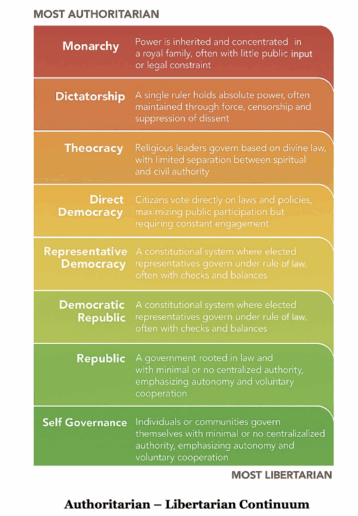
The COVID-19 pandemic provided a real-time experiment in authoritarian governance within democratic societies. The response revealed, with crystal clarity, who instinctively reaches for coercive state power and who resists it.
Consider what actually happened: Governors like Gavin Newsom, Tim Walz, J.B. Pritzker, and Andrew Cuomo shut down businesses, closed schools, banned gatherings, and enforced their edicts with fines, arrests, and revoked licenses. They encouraged neighbors to report on each other for gathering violations. People were arrested for paddleboarding alone in the ocean, for opening their businesses, for holding church services. Dying patients were denied the comfort of their loved ones in their final moments, a cruelty that no emergency could justify.
The financial system was weaponized to suppress dissent. People questioning policies were de-banked, placed under surveillance, and censored on social media platforms at the request of government officials. The Canadian government froze the bank accounts of truckers protesting vaccine mandates and their supporters.
PayPal tried to fine users $2,500 for spreading what it considered “misinformation.”
Children who faced little to no risk from COVID-19 were kept out of school for months or even years in some districts. The educational harm, especially to poor and minority children who couldn’t access private schools or tutoring, may never be fully repaired. Small businesses were wiped out while large corporations stayed open. The transfer of wealth from the middle class to the elite was unprecedented.
Conservatives didn’t enact these policies. While a few Republican governors briefly imposed restrictions in March 2020, the longest lockdowns, most extended school closures, strictest mandates, and harshest enforcement came mostly from Democrat-led states and cities. Florida opened schools in fall 2020; California kept many closed through 2021. South Dakota never imposed a lockdown. The pattern was clear.
This wasn’t about science—studies from Sweden and Florida showed that less restrictive approaches achieved similar or better health outcomes without the severe collateral damage. It was about power and the willingness to use it. The leaders most comfortable wielding expansive government authority to control individual behavior “for the greater good” came from the same political tradition that favors government intervention in healthcare, education, energy, and every other aspect of life.
This violence was imposed on the entire American population by leaders who justified their authoritarian rule by appealing to public health and the common good. But every authoritarian in history has justified their power with noble-sounding goals. The Soviet Union claimed to be building a workers’ paradise. The Nazis claimed to be saving civilization. The path to tyranny is always paved with good intentions and emergency powers.
The assassination of Charlie Kirk represents the physical violence that emerges from this toxic political climate. When half the country is routinely labeled as “fascists” or “threats to democracy,” is it surprising that some disturbed individuals take that rhetoric seriously? When political opponents are dehumanized as existential threats rather than fellow citizens with different ideas, violence becomes almost inevitable.
The solution isn’t to secure a partisan victory but to completely change the conversation. We need to stop asking “left or right?” and start asking “freedom or force?” We must recognize that most Americans, regardless of party, share more similarities with each other than with authoritarians, no matter their party label.
A liberal who believes in free speech and a conservative who believes in due process are natural allies against authoritarianism. A progressive who opposes corporate surveillance and a libertarian who opposes government surveillance should be working together. A Democrat who believes in bodily autonomy and a Republican who believes in medical freedom share the same fundamental principle.
Our founding documents didn’t establish a left-wing or right-wing government—they established a limited government, bound by law, focused on protecting individual rights. The Bill of Rights doesn’t mention political parties; it highlights fundamental freedoms that all Americans possess, regardless of their political beliefs.
Authoritarians are a small minority in this country, but they are an organized and driven group. They pursue positions of influence and are willing to use that power to enforce their will. Most Americans who value freedom must recognize this threat and come together against it, regardless of party affiliations.
This reframing isn’t just an academic exercise—it’s essential for the survival of our republic. When we correctly identify authoritarianism as the threat, rather than getting distracted by partisan labels, we can build the coalitions necessary to defend freedom.
This means liberals and conservatives coming together to defend free speech against censorship. It means progressives and libertarians uniting to oppose surveillance and the security state. It means Democrats and Republicans working together to ensure that emergency powers are truly temporary and limited.
We need to judge political leaders not by their party affiliation but by their respect for constitutional constraints, the rule of law, and individual liberty.
The tragic death of Charlie Kirk should remind us that political violence—whether it comes from a lone gunman or from government enforcement of unconstitutional edicts—is the enemy of a free society. We honor his memory not by deepening partisan divisions but by recommitting to the principles of peaceful discourse, limited government, and individual liberty that make such discourse possible.
Looking ahead, Americans face a choice. We can continue the tribal warfare between “left” and “right,” calling each other Nazis and communists while real authoritarians accumulate power. Or we can recognize that the true divide is between those who trust free people to make their own choices and those who believe they should make those choices for others.
My experience infiltrating extremist groups taught me that authoritarians will use any ideology—racial, religious, economic, or even public health—to justify their control over others. They’re not interested in debate or persuasion; they’re interested in power. The only effective response is for free people to unite across traditional political lines in defense of liberty.
This isn’t about abandoning deeply held beliefs about policy. Liberals and conservatives will continue to disagree over tax rates, foreign policy, and the proper scope of government services. But these disagreements should occur within a framework of constitutional governance and respect for individual rights. We can debate healthcare policy without forcing people into government programs. We can discuss education without giving bureaucrats total control over children. We can address public health without suspending the Bill of Rights.
The authoritarians want us divided along traditional partisan lines because it prevents us from uniting against their encroachments on freedom. Every time we call mainstream conservatives “fascists” or mainstream liberals “communists,” we obscure the real threats and make genuine coalition-building impossible.
America’s founding principles—individual liberty, limited government, rule of law, and constitutional governance—aren’t conservative or liberal. They’re the foundation that allows both philosophies to coexist peacefully. It’s time we unite around these principles once again, before the authoritarians among us exploit our divisions to destroy them entirely.
The question before us isn’t whether we’ll be a left-wing nation or a right-wing nation. It’s whether we’ll remain a free nation at all.
We fought this battle 250 years ago against the world’s greatest power. The church played a key role in securing the freedoms we enjoy today.
Sadly, today, many churches seem to have reversed course and taken the side of the authoritarians. Many churches and religious organizations promoted and financially benefited from the massive illegal immigration of the Biden years.
The Biden administration ignored the law, and many churches praised him for it. These same churches quickly embraced the racist and bigoted DEI initiatives that spread throughout our culture, initiatives that labeled white men as the primary oppressors. During the pandemic, most churches meekly submitted to illegal lockdowns, vaccine mandates, restrictions on weddings and funerals, and every other authoritarian abuse of power.
What transpired during the pandemic was the most widespread suspension of constitutional rights in American history—surpassing even wartime restrictions. The First Amendment (religion, assembly, speech), Fourth Amendment (surveillance), Fifth Amendment (property rights), and Fourteenth Amendment (due process, equal protection) were all effectively suspended in many jurisdictions.
The churches said nothing. And they are taking the wrong side again.
If churches have spoken about the “No Kings” marches, which were organized to protest the arrest and deportation of illegal aliens, the deployment of National Guard troops to protect federal property and personnel amid lawlessness, and the refusal of local officials to provide support and protection, their stance has been to oppose the government.
Every action the current administration has taken has been lawful, and many have been aimed at correcting the lawless, authoritarian actions of the previous administration.
Our churches need to wake up and realize that protests like the “No Kings” marches are being promoted and funded not by freedom fighters, but by those who would take away our freedoms.
It’s widely reported that these activities are funded by a vast network of left-wing organizations—Arabella Advisors, Tides Foundation, Open Society Foundation, and many others. These groups gather and secretly distribute tens of millions of dollars of dark money from genuine communist sympathizers like Neville Roy Singham, a billionaire American originally from Chicago now living in Shanghai, who has very close ties to the Chinese Communist Party.
Church leaders and members need to be more diligent in researching the facts to uncover the full story, rather than seizing on narratives that only seem to promote Christian principles. The false claims of the “No Kings” protest are easily exposed with minimal investigation. It may take a little longer to uncover the malevolent sources of funding for these events, but that’s the job we are called to do—find the truth and expose it. Stop being fooled by the false prophets.


